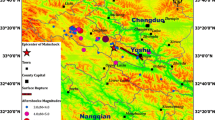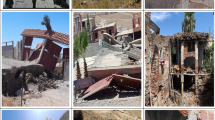Abstract
On March 4, 2010, at 08:18 local time, an earthquake with a magnitude of ML 6.4 hits southern Taiwan. The earthquake occurred in the mountainous area of Kaohsiung County at a depth of 22.64 km. The epicenter was located in the area struck by the 2009 Morakot Typhoon, which destroyed nearly 2,000 houses, leaving 461 people dead and 192 missing. Trapped residents were moved from the affected regions, and the earthquake did not cause any deaths, but injured 96 people. Damage reports were also issued on low-rise and mid-rise reinforced concrete (RC) buildings located 30 km or more from the epicenter. This paper presents the main results of a damage investigation on the largest seismic disaster in a century in the county of Kaohsiung. The focus was on the damage incurred by different types of building structures, including governmental, religious, commercial, and residential buildings. Detailed descriptions are given of the structural configurations as well as the types of damage sustained by five selected buildings. Suggestions are also made to prevent similar damage to low-rise RC buildings in a future disaster.








Similar content being viewed by others
References
ACI Committee 440 (2010) Guide for the design and construction of externally bonded FRP systems for strengthening concrete structures
Bachmann H (2003) Seismic conceptual design of buildings—basic for engineers, architects, building owners, Federal Department of the Environment, Transport, Energy and Communications. http://www.Sfcapss.Org/Pdfs/Heretodayheretomorrow.Pdf
Christopoulos C, Garcia DL, Tsai KC (2005) Educational reconnaissance of the area affected by the 1999 Chi–Chi earthquake—Three years later. Earthq Spectra 21(1):31–52
CWB (2000) Seismic intensity scale. http://www.cwb.gov.tw/V7e/earthquake/quake_preparedness.htm
Ehsani MR, Saadatmanesh H (1996) Seismic retrofit of URM walls with fiber composites. Mason Soc J 14(2):63–72
Ehsani MR, Saadatmanesh H, Velazquez-Dimasi JI (1999) Behaviour of retrofitted URM walls under simulated earthquake loading. J Compos Constr ASCE 3(3):134–142
Kuwamura H, Sasaki M (1990) Control of random yield-strength for mechanism-based seismic design. J Struct Eng ASCE 116(1):98–110
Li Shuang, Xie Lili (2007) Effects of hanging wall and forward directivity in the 1999 Chi–Chi earthquake on inelastic displacement response of structures. Earthq Eng Eng Vib 6(1):77–84
Lin BC (2011) Experiment and analysis of confined masonry wing-walls under in-plane loading. Thesis for the M.S. degree at National Cheng Kung University, Tainan (in Chinese)
Loh CH, Tsai KC, Chung LL, Yeh CH (2003) Reconnaissance report on the 31 March 2002 earthquake on the east coast of Taiwan. Earthq Spectra 19(3):531–556
NCREE (2010) Reconnaissance report on Jiaxian earthquake in Kaohsiung on March 4, 2010. National Center for Research on Earthquake Engineering. http://www.ncree.org/ZH/PublicationProfile.aspx?ID=10700
Promis G, Ferrier E, Hamelin P (2009) Effect of external FRP retrofitting on reinforced concrete short columns for seismic strengthening. Compos Struct 88:367–379
Pukl R, Novák D, Bergmeister K (2003) Reliability assessment of concrete structures. In: Bicanic N et al (eds) Computational modelling of concrete structures (Euro-C 2003), St. Johann in Pongau, Austria. Balkemapp, Lisse, pp 793–803
Pukl R, Červenka J, Červenka V, Novák D, Vořechovský M, Lehký D (2005) Deterministic and statistical models for nonlinear FE analysis of FRC-based structures. In: Proceedings of the 1st Central European congress on concrete engineering, Graz, Austria
Schwegler G (1994) Masonry construction strengthened with fiber composites in seismically endangered zones. In: Proceedings of the 10th European conference on earthquake engineering, Vienna, Austria
Tryland T, Clausen AC, Remseth S (2001) Effect of material and geometry variations on beam under patch loading. J Struct Eng ASCE 127(8):930–939
Zhang J, Ellingwood B (1995) Effects of uncertain material properties on structural stability. J Struct Eng ASCE 121(4):705–716
Author information
Authors and Affiliations
Corresponding author
Rights and permissions
About this article
Cite this article
Chang, HY., Lin, KC. Reconnaissance observations on the buildings damaged by the 2010 Taiwan Kaohsiung earthquake. Nat Hazards 69, 237–249 (2013). https://doi.org/10.1007/s11069-013-0703-1
Received:
Accepted:
Published:
Issue Date:
DOI: https://doi.org/10.1007/s11069-013-0703-1




